
Art of the Ages
Knowledge on the rocks
The first time I ever saw a pictograph was during my very first tour, back in 01993. The information I had at hand informed me that there were examples of ancient paintings on an exposed rock alongside the highway on which I was riding in eastern Oregon. However, when I reached the spot where they were to be found I was saddened to see that they had been defaced by some thoughtless misanthrope who had obscured them with graffiti relating to a "modern" religion. Not one to give in to such a problem, I waded out into the chilly water of the adjacent river, which shared the gorge with the highway, and, once there, was able to see a few undisturbed pictures, faded, but discernable. It was a very moving experience for me, since, as someone who grew up in eastern North America, opportunities to witness messages left behind by someone from an early culture, perhaps from thousands of years ago, had not come along very often. As it turned out, it would be many more years, not until I was on the Tour of Gondwana, until I would be able to repeat that experience.
First a little background would seem to be in order. Pictographs are one of two main types of "Rock Art" that were created by our distant ancestors millennia ago, the other being Petroglyphs. The difference between the two arises from the method in which they were created, and I must confess that I have gotten the names confused on many occasions throughout the years. Pictographs are paintings made on stone surfaces, using whatever type of pigments the ancients had available. The examples that survive today are only those for which the paint used proved to be chemically compatible with the rock and able to withstand thousands of years of exposure to the elements. On the other hand, petroglyphs are somewhat more durable, as they are made by physically carving a design into the rock surface itself. Most of the rock art sites that I have seen until now have contained pictographs, which is fine by me, as I find them to be a little more artistic, attractive, and interesting.
The subjects of the paintings themselves may be any of several general types; geometric or abstract designs; representations of real people, hunters for example; mythological creatures or people; and, especially, animals. The latter is the most interesting because it shows what was important to the creators of the art, and may also provide valuable information regarding the environment in which they lived. In more than one instance pictographs display animals that have long been extinct in the region in which the paintings exist. With regards to why the paintings were made, or what message, exactly, they were meant to convey, in most cases no one knows for sure, and, in all probability, no one ever will. One thing that can be assumed, reasonably, is that they were created by people who were nomadic or semi-nomadic. The reason being that once a people became fixed to one particular location, and began living in cities, or their precursors, they more than likely would have created art in, or on, their dwellings, instead of on a lonely rock, on a cliff-face, or in a cave. Because of that fact, pictographs and petroglyphs provide one of the few windows we have into the cultures of our globe-roaming ancestors. That is useful information to have, as humanity employed that mode of living far longer than we have been civilized and, especially, industrialized.
During the Tour, I was fortunate enough to see a variety of pictograph sites while riding Stages 1, 3 and 4. India and Southeast Asia contain many excellent rock art sites, some of which are exquisitely made and very ancient, as do Mexico and the Southwestern U.S., but none of those sites could be practically reached from the Stage 2 or 5 routes. That underscores a typical difficulty in trying to observe rock art while on a long tour. Many of the best sites are located well off the beaten path, away from the major touring routes, often at the end of a tortuously bumpy, dead-end dirt track. Those that are easily accessible have all too frequently been vandalized, or carried off to be displayed in another location. Some sites are off limits to visitors for cultural reasons, or for the protection of the paintings themselves. So, I feel quite fortunate to have seen art at several sites that I was able to visit during the Tour, many of which are presented below, ordered according to the age of the cultures which created them, with the oldest first.
San Pictographs of Southern Africa
The San people are the amazing hunter-gatherers of southern Africa. Though today their home territory has been diminished to small areas of the Kalahari Desert, throughout much of human history they hunted freely through most of sub-Saharan Africa. Most of the Rock art sites in that region, therefore, were created by San artisans. That is quite relevant, as they are probably the most closely related to the culture that gave rise to all of the societies found in the World today. I was able to see San pictographs at two sites; Mwela Hill, as small rocky outcrop northeast of Kasame, in Zambia; and uKhahlamba-Drakensberg National Park in South Africa, near the border with Lesotho. The latter site required a hike of a few hours, led by a park ranger, which included some spectacular scenery as well as the small, but interesting, pictograph site under a rocky overhang. At Mwela Hill, a friendly local man served as the caretaker of the site, which is located in an otherwise nondescript rock hill, and it would have been very difficult to locate the paintings without his assistance.
He also informed me that the paint the San used usually contained blood, a common source of iron pigments, and that caused their paintings to be rather less durable than some others. So, while the San people, and their ancestors, had lived in the area for a hundred thousand years, or more, the paintings that exist today may only be one or two thousand years old. Some of their works were a little abstract, but most seemed to focus of the matter of obtaining food from the local animal population. This can be seen in the hunting-related images below. In the Mwela Hill image, small hunters appear to be crouching in the brush, stalking their prey, which can be partially seen as the large red blob on the left side of the image. This reveals a basic understanding of the principals of scale, with the distant humans appearing to be much smaller than their nearby prey. In the second image, hunters with spears seem to be in hot pursuit of their target, or perhaps they are celebrating a successful hunt, which might explain the person apparently doing handstands.

Human hunters at Mwela Hill, Zambia

Energetic hunters at uKhahlamba-Drakensberg
Images of animals were also seen frequently at these two sites. Examples are the anteater, rhinoceros, and big cat, shown below. These show a certain style that I often observed at the rock art sites I saw, as well as others throughout the World, of which I have seen published images, where the animal's torso is somewhat exaggerated in size relative to its head and appendages. Whether that was intentional or a result of the painting method used, I have no idea.
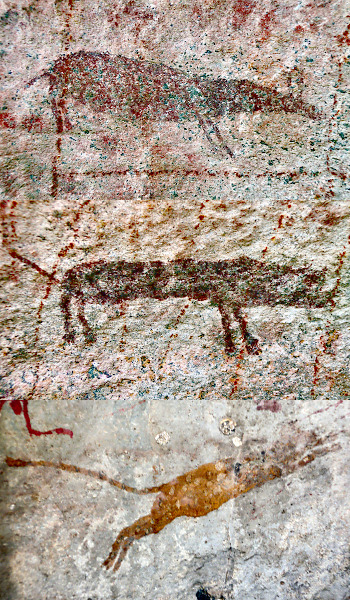
Anteater (Top); Rhinocerous (Middle), at Mwela Hill;
and Cat (Bottom) at uKhahlamba-Drakensberg
However, another, more realistic, style was also seen at the uKhahlamba-Drakensberg site, as in the image of an eland shown below. Elands are the largest of Africa's antelopes, and as such would have been a very important food source for the people of the region. Perhaps that is why this painting was done with such skill, and obvious reverence. It was one of the most well crafted of all the pictographs I have seen to date.

An beautiful Eland at uKhahlamba-Drakensberg
There were also representations of less than realistic creatures to be seen as well. An example would be these two figures. They seem to have the bodies of humans, but the heads of giraffes, or some other hoofed animal. Certainly there must have been an interesting story related to those two beings, but that, sadly, will never be known.

Unusual creatures at uKhahlamba-Drakensberg
Geometric designs are always a little harder from which to glean any meaning. Perhaps these paintings represent the Sun and the Moon, or possibly something else entirely.

Geometric representations at Mwela Hill
Aboriginal Australian Pictographs
Chronologically, the sites in Australia were the first that I saw, but they may be among the oldest on Earth. Australia's human cultures date back almost as long as Africa's, however, many of the rock art sites on that continent seem to have been used over and over again throughout the ages. Those in the northern areas of the continent may have been used as long as humans have been present, and so may date back 40,000 to 60,000 years, perhaps longer. They are also perhaps the most intriguing sites in the World, being rich with unusually imagery and painting techniques. Many are closed to outsiders, which is fine, since those that are open will satisfy just about anyone.
The pictograph sites at the base of Uluru, central Australia's iconic red monolith, were the first I came across. Seeing these sites required the services of Aboriginal guides, as well as a European-Australian ranger. As far as imagery is concerned, these sites were among the most haphazard of all the ones I observed. The design in the first image below could represent the crescent Moon, boomerangs, or something else entirely, while the red figure in the second image looks like something that might be seen in a Japanese cartoon.

Geometric designs at Uluru
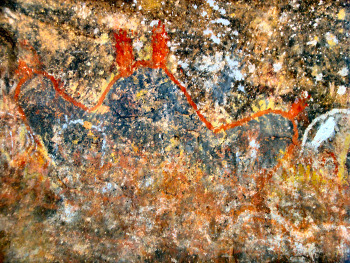
A Humanoid figure at Uluru
These sections have obviously been painted multiple times, with new paintings being placed on top of old ones in several cases. It’s a little challenging to make out anything in particular in these crowded images, but one can see a hand, an emu footprint, crescents, and several concentric circles, which are reminiscent of the paintings produced by contemporary Aboriginal Australians.
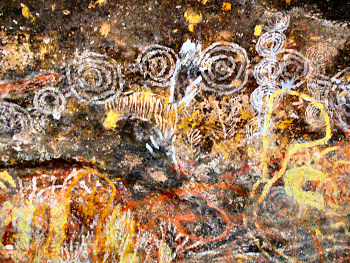
Mixed designs at Uluru

Mixed designs at Uluru
In the Northern territory, while touring through Kakadu National Park, I had the pleasure to visit two of the finest sites I have yet seen. Both of these sites were self-guided with some interpretative signage along the trail, which, as I will mention momentarily, was amazingly interesting. The first of these was the Anbangbang Gallery, which is at the base of Nourlangie Rock. There was quite a variety of subjects depicted there, and the area itself was very pretty.
One fascinating thing that could be seen there was the evolution of the area's painting styles. That can be observed in the image below, which shows four paintings of kangaroos. The first is a simple silhouette, and as the images progress towards the bottom, one can see the greater use of the famous "x-ray style" of painting commonly found throughout the region. In that type of art, the bones and internal organs of the animal are included in the paintings, in addition to its general shape. The third panel seems to depict a hunter spearing a kangaroo, but to me it looks more like a 'roo being attacked by a parrot that is riding a unicycle. Only a cyclist would see that, I suppose, but regardless, I would love to know the story behind that one.

Four kangaroos at the Anbangbang Gallery, Kakadu National Park
Apparently, most animals important to the local people found their way onto rock walls in the area, including this goanna, also in x-ray style.

Goanna at Anbangbang Gallery
Where this gallery really stood out, however, was in its depictions of mythological figures. This is where the information provided by the park proved to be invaluable. The reason that was available was that there has been a continuous oral history among the Aboriginal groups living in the area, possible dating back to when the paintings were created. That means that this site is one of the few in the World where someone can tell us what the paintings actually mean. Of course, oral history is a little like a thousand-year game of "pass it on", so no one can be exactly sure whether the meanings have change a little throughout the millennia. The quotes given here are taken from the information plaques put up by the park at the site.
No description was given about this scene. Though if it represented real people, there must have been a rather joyous fiesta going on.

Various human figures at the Anbangbang Gallery
These people were part of a large montage of figures. Their description is: "Family groups of men and women on their way to a ceremony. Flecks on the breasts of the two women on the right [not shown] indicate they are breast-feeding children."

Four-membered family at the Anbangbang Gallery
"Namarrgon is the Lightning Man. He wears his lightning as a band around him, connecting his arms, legs and head. Stone axes on his knees and elbows make the thunder."
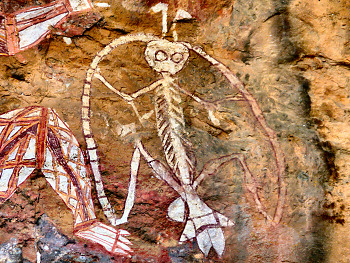
Namarrgon, The Lightning Man at the Anbangbang Gallery
"Namandjolg and his sister broke the incest laws on the rock ledge above this gallery. He later became Ginah, the great saltwater crocodile."

Namandjolg at the Anbangbang Gallery
"This is Nabulwinjbulwinj. He is a dangerous sprit who eats females after striking them with a yam. His name is pronounced Nar-bull-win-bull-win."

Nabulwinjbulwinj at the Anbangbang Gallery
The second site I visited in Kakadu, was the excellent Ubirr Gallery, in the northern part of the park. It was exceptional in many ways, including the very enjoyable ride out to the site, along a fairly good paved road. However, it is the collection of pictographs that really stood out, and made Ubirr probably the single best rock art site that I saw. There are many separate panels there which are covered with pictographs, on smooth rock faces, individual rocks, and even on the underside of high rocky overhangs. Exactly how those last paintings were made escaped my understanding. The x-ray style was common in pictographs at Ubirr, and there were often numerous representations of the same creatures. Examples are the two turtles shown below.

Two turtles at the Ubirr Gallery, Kakadu National Park
There was also a very interesting little pictograph tucked away, high on a rock wall, that appears to show a Thylacine. That particular creature, also known as the Tasmanian Tiger, has been extinct on mainland Australia for thousands of years, but survived on Tasmania until it was wiped out after the arrival of Europeans. The presence of that image demonstrates the age of the Ubirr site.

An extinct Thylacine, Ubirr
The large estuarine fish, the Barramundi, popular with sport fisherman today, was apparently also of great importance thousands of years ago to the local population. That is evidenced by the large number of representations of these fish at Ubirr. Their images are probably the best examples of the x-ray style.
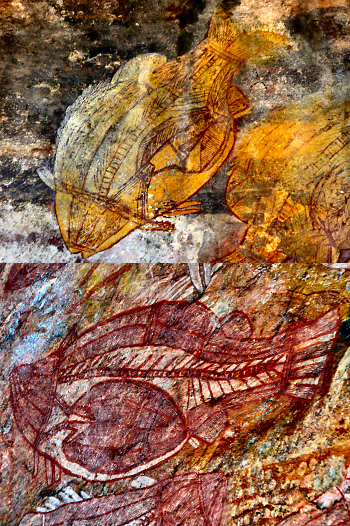
Two Barramundis at Ubirr
This image gives a broader view from the site. Various creatures can be seen, including a turtle, barramundi, a kangaroo head, and a very small human figure.

Various creatures at Ubirr
Andean Pictographs
Though there are many rock art sites in South America, there were many months and many kilometers of cycling between the two sites I was able to see. One of these was in the Altiplano of Bolivia, just south of Potosi, near the small town of Betanzos. I had seen a mention in a guidebook somewhere of an unmarked pictograph site near the highway, but I had few details about its location. Asking around in Betanzos, I was able to find the general location, somewhere near the base of a certain, rocky hill, but after an hour or two of wandering around I had not sighted a single painting. Just as I was about to give up a local woman doing her daily chores walked up, followed shortly after by her husband. I was not sure if I was trespassing or otherwise interloping, but after a little awkward questions and answers with them, the friendly couple pointed out where they paintings were, a little higher up the steep hillside than I had expected.
There were mostly geometric designs there, but there were a few recognizable images as well, such as these guanacos (or possibly vicunas,) the South American camels. These animals were of prime importance to the people of the area, as their domesticated cousins the llamas and alpacas still are today.

Guanacos at Betanzos, Bolivia
Another painting showed a rhea, the South American variety of ratite, a relative of the ostrich, which today is mainly found at lower elevations.

A rhea at Betanzos
This design could be many things. It reminded me of a spoked wheel, which I suppose isn’t surprising given my cycling nature.

Spoked wheel at Betanzos
This interesting painting could either be a simple geometric shape, like a double-pronged trident, or a four-legged creature seen from above.

Geometric designs at Betanzos
The only recognizable human figure I saw there was this stylized person. Real or mythological, no one can tell.
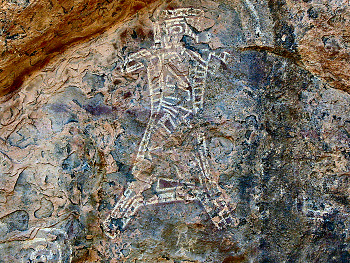
Human figure at Betanzos
Patagonian Pictographs
Further south, in Patagonia, the first site I visited on the continent was the beautiful Cueva de los Manos (Cave of the Hands.) It is located near the tiny hamlet of Bajo Caracoles. Reaching that five-building town was tough enough, involving a long stretch on the often unpaved and rocky Ruta 40, all the while battling fierce Patagonian winds. The site itself is located many kilometers off on a similarly bumpy, dead end side road leading into the beautiful Rio Pinturas Canyon. Instead of cycling out, I wimped out and hired the local man who shuttles tourists out to the site to give me a ride out and back, and once there visiting the actual site required taking a guide from the basic visitor center. Despite its name, the pictographs are not actually in a cave, but rather all along a thick exposed rock layer protruding from the canon wall. The paintings extend along the rock for a couple hundred meters, and overall the site was one of the best I saw on the Tour.
There were many paintings of Guanacos, often shown running in large herds, as in the image below, which also contains examples of the site's trademark handprints that give it its name.

Guanacos, hands, and other designs at Cueva de los Manos,
Santa Cruz, Argentina
In addition to dozens, or perhaps hundreds, of handprints, there was also at least one rhea footprint. No one can be sure if the big bird was a willing participant in the creation of that piece of art, however.

Rhea footprint at Cueva de los Manos
Despite the sites focus on hands, it seems that the artists did not have a complete grasp of the number of digits usually found on that appendage. In this image the human figure has no fingers on one hand, four on the other, and the two hand that appear to be raising a bowl have six each. I suppose that is probably just due to artistic license.

Guanacos, human figure, and six-fingered hands at Cueva de los Manos
Common Threads
One thing that can be said for sure with regards to rock art is that, while there are many opinions as to the purpose and meanings of the images left behind from past eras, in almost every case no one can say for sure exactly what they mean. I have read various theories regarding their purpose, but without any possibility of obtaining any real evidence of their meaning, all such proposals are mere suppositions. With that in mind, and because, in that situation, any idea has as much validity as any other, I will put forward my own thoughts.
I feel that the rock art sites I saw, and possibly many of the others in other parts of the World, all served the same purpose; they were classrooms. I imagine groups from various nomadic cultures returning to the same spots, time and time again, as they moved about their home territories. At those places the younger members of the group were taught things that would be important to their personal and cultural survival. The best way to hunt a warthog, perhaps. Or a guanaco, if that was the common herbivore around their home. Also in the curriculum would be the oral traditions and stories that bound the community together and provided the moral framework that held the culture together, such as, how to stay out of trouble when the Lightning Man was in the area. All of these lessons would be enhanced by the presence of fanciful representations of their subjects on the nearby rock face, giving a visual reinforcement to the elder's stories. What better way to convey importance to youthful minds? I can almost hear the teacher speaking now: "Look here, children, this is an Eland, one of the most important animals for our people. This picture has been here longer than any of us can remember, and what I am about to tell you is the way things have always been…" To me this beautiful image simply makes a lot of sense.
Another thing that fascinates me about rock art is the great similarities that can be seen between the pictographs made by peoples separated by so much time and distance. Except in cases where characteristic animals are shown, kangaroos or rhinos, for example, or where certain special techniques were used, such as the x-ray style in northern Australia, trying to identify the location at which a random pictograph was created could be a real challenge. To illustrate that point, consider the following two sets of images.
The first has panels from Mwela Hill and Cueva de los Manos. Both contain areas painted with a pattern of red dots. Could they be schematic maps or instructions of some sort? Again, no one will ever be able to say for sure, but the similarity of the imagery is undeniable.

Dot-style pictographs at Mwela Hill and Cueva de los Manos
Even more compelling to me is this set of images, from Ubirr, and Cueva de los Manos, showing handprints painted with a virtually identical stenciling method. Prints like those give a true human connection between the artists and the visitor. The Patagonian site had the best collection of the sites I saw, but there are pictograph sites with similar handprints in many other locations throughout the World, including some truly remarkable collections at some of the non-accessible sites in Australia. If places like these were indeed classrooms, then perhaps "graduates" traditionally left their mark as a handprint when they had learned the skills they needed to survive. Or, perhaps the teachers themselves left prints of their hands, as a testament to the truthfulness of the information they provided. In any case, those were truly impressive sights.
Hand print pictographs at Ubirr and Cueva de los Manos
What does this tell us about our distant ancestors, and therefore, about ourselves? The images above were created by different peoples who could not have had any knowledge of each other. Southern Africa and Australia are two of the parts of the Earth which have been inhabited by humans longer than any others. Patagonia is one of the places where humans have lived for the shortest length of time. These regions are separated by thousands of kilometers of ocean and tens of thousands of years of cultural history. Yet looking at these paintings, it is obvious that their creators thought in the same ways. The same things were important to each of them; the creatures they depended on and shared the World with, and the stories they told each other. Were they really that different from each other? Were they that different from us today? Are all of us living today that different from each other? To me, the answer to each of these questions is clearly, no.
I wish that I could have managed to ride to more pictograph sites during the Tour. I think that should I be able to do so again in the future, I will learn the same lesson again each time.
Previous | Next
Main Index | Pre-Tour Index
Post-Tour Index | Articles Index
Slideshows
Main Index Pre-Tour Post-Tour Articles Previous Next |
To Make a Good Paint
I am in no way whatsoever an authority of the methods and materials that our forbearers used thousands of years ago to produce art on rock surfaces. However, in my pre-Tour life my field of work was inorganic chemistry and materials science, so I certainly have an interest in that topic, and enjoy speculating on how natural materials can be used to create lasting works of art.
In order for a pictogram to survive for any length of time, let alone millennia, a few factors needed to be addressed in the production of the paint to be used. Whether those who once created rock art knew, or even cared, that their paintings would survive longer than a generation, let alone indefinitely, can never be known. We can also not be sure whether the paintings we see today used paints that were the product of many years of trial and error, ultimately leading to a good paint, or simply lucky combinations influenced by what materials were available in the local area. It is certainly possible that there were a large number of paintings created over the ages using inferior paints, which never lasted long and of which we know nothing. On the other hand, many of the minerals frequently used for pigments are not all that uncommon, and would likely have been obvious choices for anyone wanting to be an early artist. This idea is reinforced by the fact that many paints used in disparate regions of the globe often employed similar constituents.
Unlike many modern paints, which form a thick, integral coating over top of the underlying surface, any successful paint for rock art, if it were to last long at all, would need to use a different approach. The effects of weathering would undoubtedly remove any type of coating applied to a rock surface. A pigment that would chemically bind to the rock itself, primarily in a thin layer, would be much more likely to last and resist the actions of rain, sun, and wind. For that to occur, both the pigment and the rock surface would need to be chemically compatible. With most rocks on earth being composed of mineral oxides, similarly constituted pigments would be a logical choice. Various powdered oxides, predominantly those of iron, possess the reactivity needed to bind to rock, as well as sufficient color to make them attractive pigment. The range of colors is not all that wide, however, which is why the most common colors seen in pictographs are red, yellow, white, brown, and black. Analyses of pigments from many sites have revealed the common use of a handful of pigments and other constituents throughout the World, as listed below. Modification of the pigments color by the application of heat, which removes coordiated water and may convert a material to a different cryatslline form, may also have been used. If that were the case, producing new pigments may have been one of the first uses of fire to prepare new materials, and, therefore, may represent the precursor of processes such as metalurgy.
More than a simple mineral powder would need to be used, however. For a simple mineral powder would not adhere well to a rock surface on its own. It may have been advantageous to treat either, or both, of the rock surface and pigment with an agent to adjust its pH, to enhance the subsequent bonding. That could have been an acid, from a plant source, for example, or an alkaline material from an alkali pond. However, all traces of such treatments would quickly be leached away by environmental water, and so their use will probably never be confirmed. A good paint would also need some type of binder, to maintain the cohesion of the painting until the paint has dried and reacted completely with the rock surface. Organic materials derived from plants, saps, juices, and crushed solid parts of the plant, would all be potentially useful as binders. Ideally these materials would help the pigment adhere to the rock initially, and then either become an integral part of the artwork, or subsequently removed by natural oxidation, or other processes. An interesting material found in various pictographs is the mineral Whewellite, or calcium oxalate. That compound is present in many types of plants, and it can easily form polymeric structures that would form an excellent binder. Plants of the genus Aloe, common succulents found throughout Africa, typically produce a thick sap that may contain oxalates. They may have provided a component for the paints used by the San people, possibly the first artists on Earth.
A few other considerations would need to be addressed, such as the viscosity of the paint. Painting with a brush, or similar tool could employ a rather thick paint, whereas stenciling, the method clearly used to produce the numerous handprints found at pictograph sites worldwide, would need a drier composition that could easily be sprayed with or without the aid of a blowpipe. What is certain is that the techniques for making good paints were some of the first technologies developed by our species, and the artisans that produced rock art were probably the World's fist chemists.
Pictograph Pigments
Hematite
Red ochre
α-Fe2O3
Red
Goethite
Yellow ochre
α-Fe2O3�H2O
Yellow-brown
Goethite
Raw sienna
α-Fe2O3�H2O
Brown-red
Raw Umber
Fe2O3�MnO2�H2O
Brown-red
Lepidocrocite
γ-Fe2O3�H2O
Grey-black
Charcoal
C
Black
Pyrolucite
β-MnO2
Black
Magnetite
Fe3O4
Black
Quartz
SiO2
White
Huntite
CaMg3(CO3)4
White
Kaolinite
Al4Si4O10(OH)8
White
Calcite
CaCO3
White
Gypsum
Ca(SO)4�2H2O
Clear-white
Whewellite
CaC2O4�H2O
White